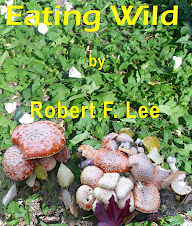Wait! Don’t reach into your cupboard for that bag of dried tea leaves to quench your thirst. Step a few feet into the fields, or along some creek bed and pick a few handfuls of strawberry and raspberry leaves to make a fresh leaf tea. While you are along that wetland, grab a couple of sprigs of wild spearmint or catmint to toss into the drink.
Each year, consumers spend tens of millions of dollars on an array of herbal teas off the retail shelves, while a huge diversity of tea options await in the wastelands and fields of North America. Of the dozens of possible plants awaiting your picking, two of the most common are strawberry and raspberry plants, along with wild chamomile, mint and rose (rose hips). While not as popular in the USA as in Canada, commercial teas such as Liptons assortments are purchased year-round, either for use as a hot or cold tea.
Strawberry and raspberry teas are particularly easy to work with, being used fresh or dried. We commonly pick bagfuls of leaves in the early summer, then dry them in on a screen in a shaded area before crushing the leaves and bagging them to be used over the winter months. However, the best tea is made from fresh leaves, picked, bruised by mashing and scraping them with a fork to release the oils and flavour, then making a tea infusion by steeping them in boiled water for ten to fifteen minutes. For colour, throw in a couple of berries. For zest, toss in two mint leaves.
Summer, though, is not the peak demand season for hot tea. Yet, strawberry and raspberry teas (particularly with the mint sprigs) make excellent iced teas, as well. Chill in the refrigerator and toss a couple of ice cubes into your glass, to enjoy a very lively and healthy summer drink.
Strawberries and raspberries contain antioxidants (to fight cancer), plus good amounts of vitamin C, manganese and B vitamins. As well, both are good sources of dietary fibre and are anti-inflammatory and astringent. These last two properties make them valuable as a treatment for wounds, and work well to treat kidney stones, gout and other urinary problems. North American natives used strawberry to treat jaundice and upset stomach, Europeans used the plant to treat bad breath and skin problems and ancient Romans used the plant to treat melancholy and nervous problems.
Although the root is valued for its health benefits, harvesters are advised to focus on the leaves and fruit.
Raspberry is valued for many of the same medicinal and nutritional qualities as strawberry, and, like strawberry, yields its root , fruit and leaves for consumption. Yet, young raspberry shoots, when peeled in early spring, are wonderfully tender and can be eaten raw.
Although strawberry and raspberry teas form the most common uses for harvested plants, juvenile strawberry leaves add a light taste to fresh salads. Crushed and mixed with olive oil, they make a good dressing. But their best use is with wild meats and cold vegetable soups. Create a strong tea infusion by pouring three cups of boiled water over two cups of crushed and packed leaves, then let stand for half an hour. Strain and use the liquid as you would water in zucchini, tomato, potato, pumpkin or other vegetable soups. As a seasoning for meat, dry the leaves, crush them, and let them steep in an olive oil infusion before brushing the blend on barbequing red meats, along with fresh Saskatoon or blueberries. The meat will sing!
Of course, picking your own tea, soup or meat spices in the wild is a personal choice. But it is a choice that not only is free, it is delightfully tasty!
Tuesday, June 28, 2011
Monday, June 13, 2011
A Rose, By Any Other Name -- Would Be Just As Beneficial To You
The wild rose may be the provincial flower of Alberta, but it is found across almost all of the Midwest and western parts of North America. Its pale pink to bright mauve flowers are one of the earliest summer blooms, and one of the most enduring sights throughout June, July and August, giving way only to the red blush of rose hip bulbs in late summer and early fall. The fragrance of these sweet roses draws insects, birds and humans alike. Yet, the wild rose grows predominantly in marginal soils and headlands or bush tree lines, and offer branches with irritating small prickly thorns.
Aside from its appeal as a flower and summer braggart, the rose is a great find for the avid wild harvester, with its flower petals and rose hips providing great medicinal, nutritional and cosmetic benefit.
Last year, for example, I crushed a pound of petals and make an infusion, then blended the alcohol-based scented mix with gelatine. My wife enjoyed this homemade soap, finding it a wonderful skin stimulant, an aromatic cleanser and a great boost to her complexion.
Because it is a "dry" oil, the skin soaks it up quickly. Being naturally antiseptic, it is great for irritated skin and even for treatment of mild scar tissue. Unfortunately, unless frozen, rose petals so not store well, and will quickly turn rancid in heat.
Of course, rose petals make a wonderful potpourri when dried, using a dehydrator. Sun-drying squeezes all of the colour from rose petals, rendering them quite unattractive.
Rose hips make a wonderful tea, or a great spice or supplement to some meats.
To make rose hip tea, grind the dried hips in a small coffee bean grinder, then make an infusion by steeping for ten minutes in boiled water. To eliminate the unpleasant ground and remnants, use a cheesecloth bag (available at craft stores). Tea balls do not filter enough of the fine seed within the rose hip. To dry the hips, place in full sun on a screen for several days, or use a dehydrator for 10-12 hours. They will keep for over a year in a plastic sealed container!
Nutritionally, rose hips are an excellent source of Vitamin C. They can be used fresh or dried, and even preserved or made into a jelly, jam or sauce. Rose hips go well with wild meats, add great taste to stews or soups, and can even be made into pies (although I recommend using only ¼-1/3 rose hips with other berries).
Medicinally, rose hips are used by those suffering with joint pain, osteoarthritis, kidney or bladder infections and even diarrhea. Rose hips are used to treat cardiovascular disease, and contain known anticarcinogens.
Because roses grow so abundantly, they, like other common wild plants such as dandelion and cattails, frequently are overlooked as a great natural remedy or food source, yet offer year-round relief and nourishment. The rose hips, unless captured by scavenging birds, often will be found in early spring, having overwintered the harshest conditions and deepest snows. Anything that tough must, it seems, be good for you!
Aside from its appeal as a flower and summer braggart, the rose is a great find for the avid wild harvester, with its flower petals and rose hips providing great medicinal, nutritional and cosmetic benefit.
Last year, for example, I crushed a pound of petals and make an infusion, then blended the alcohol-based scented mix with gelatine. My wife enjoyed this homemade soap, finding it a wonderful skin stimulant, an aromatic cleanser and a great boost to her complexion.
Because it is a "dry" oil, the skin soaks it up quickly. Being naturally antiseptic, it is great for irritated skin and even for treatment of mild scar tissue. Unfortunately, unless frozen, rose petals so not store well, and will quickly turn rancid in heat.
Of course, rose petals make a wonderful potpourri when dried, using a dehydrator. Sun-drying squeezes all of the colour from rose petals, rendering them quite unattractive.
Rose hips make a wonderful tea, or a great spice or supplement to some meats.
To make rose hip tea, grind the dried hips in a small coffee bean grinder, then make an infusion by steeping for ten minutes in boiled water. To eliminate the unpleasant ground and remnants, use a cheesecloth bag (available at craft stores). Tea balls do not filter enough of the fine seed within the rose hip. To dry the hips, place in full sun on a screen for several days, or use a dehydrator for 10-12 hours. They will keep for over a year in a plastic sealed container!
Nutritionally, rose hips are an excellent source of Vitamin C. They can be used fresh or dried, and even preserved or made into a jelly, jam or sauce. Rose hips go well with wild meats, add great taste to stews or soups, and can even be made into pies (although I recommend using only ¼-1/3 rose hips with other berries).
Medicinally, rose hips are used by those suffering with joint pain, osteoarthritis, kidney or bladder infections and even diarrhea. Rose hips are used to treat cardiovascular disease, and contain known anticarcinogens.
Because roses grow so abundantly, they, like other common wild plants such as dandelion and cattails, frequently are overlooked as a great natural remedy or food source, yet offer year-round relief and nourishment. The rose hips, unless captured by scavenging birds, often will be found in early spring, having overwintered the harshest conditions and deepest snows. Anything that tough must, it seems, be good for you!
Labels:
cosmetic,
medicinal,
medicine,
natural filter,
natural medicine,
rose,
rose nutrition,
rose petal,
rosehip,
rosehips
Subscribe to:
Posts (Atom)

